The NVIDIA GeForce GTX 1080 & GTX 1070 Founders Editions Review: Kicking Off the FinFET Generation
by Ryan Smith on July 20, 2016 8:45 AM ESTGrand Theft Auto V
The latest edition of Rockstar’s venerable series of open world action games, Grand Theft Auto V was originally released to the last-gen consoles back in 2013. However thanks to a rather significant facelift for the current-gen consoles and PCs, along with the ability to greatly turn up rendering distances and add other features like MSAA and more realistic shadows, the end result is a game that is still among the most stressful of our benchmarks when all of its features are turned up. Furthermore, in a move rather uncharacteristic of most open world action games, Grand Theft Auto also includes a very comprehensive benchmark mode, giving us a great chance to look into the performance of an open world action game.
On a quick note about settings, as Grand Theft Auto V doesn't have pre-defined settings tiers, I want to quickly note what settings we're using. For "Very High" quality we have all of the primary graphics settings turned up to their highest setting, with the exception of grass, which is at its own very high setting. Meanwhile 4x MSAA is enabled for direct views and reflections. This setting also involves turning on some of the advanced redering features - the game's long shadows, high resolution shadows, and high definition flight streaming - but it not increasing the view distance any further.
Otherwise for "High" quality we take the same basic settings but turn off all MSAA, which significantly reduces the GPU rendering and VRAM requirements.


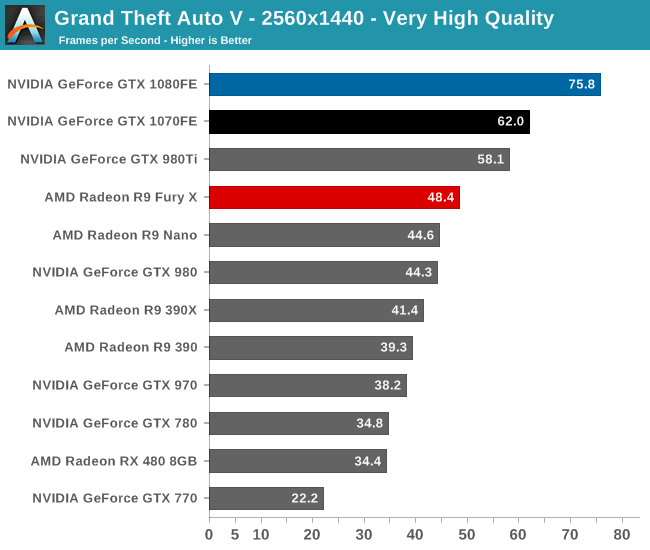
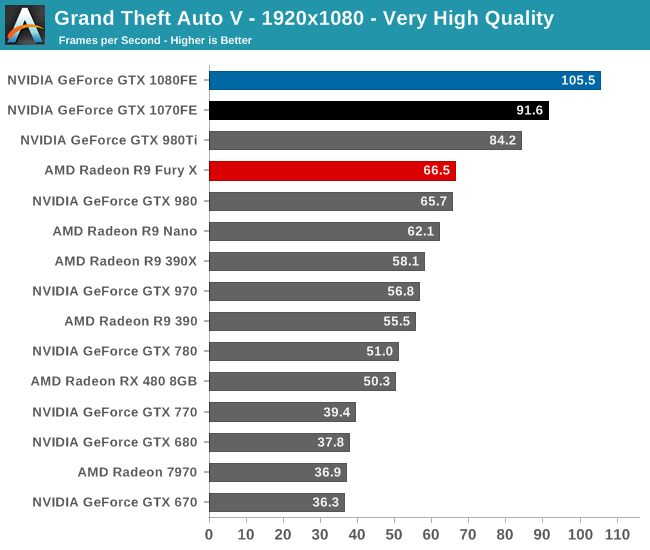
GTA V is another game that in recent times has favored NVIDIA GPUs, and as a result the GTX 1080 enjoys a solid standing here. At 61.4fps, the card becomes the first card to crack 60fps at 4K, albeit at only High quality. For very high quality, it becomes the first card to crack 30fps, both reinforcing how much of an improvement the card is over the previous generation and at the same time highlighting that it’s still going to have to make quality tradeoffs for 60fps at 4K.
Second to only the GTX 1080 is of course the GTX 1070. 4K is arguably out of the question, but at 1440p it can do just better than 60fps, making it the second card to do so. And though largely symbolic, it manages to do so when the GTX 980 Ti could not.
Looking at the generational improvements, GTA shows slightly better than average scaling with the new Pascal cards. GTX 1080 holds a anywhere between a 61% and 71% lead over the GTX 980, with particularly good gains above 1080p. Meanwhile GTX 1070 averages just shy of 60% over its GTX 970 counterpart.
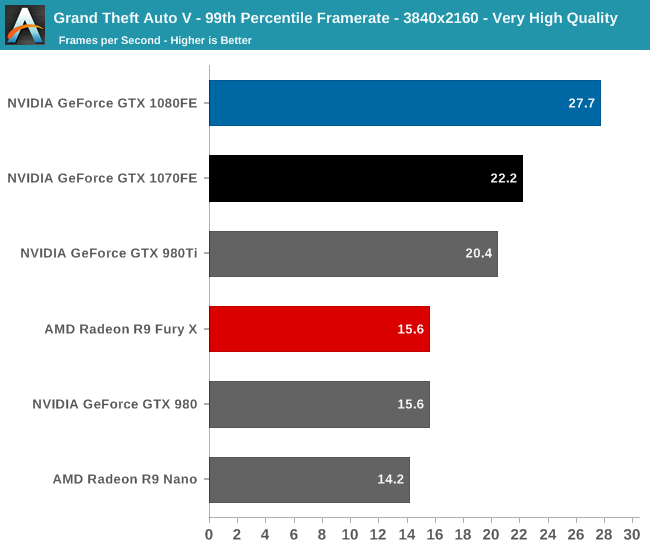
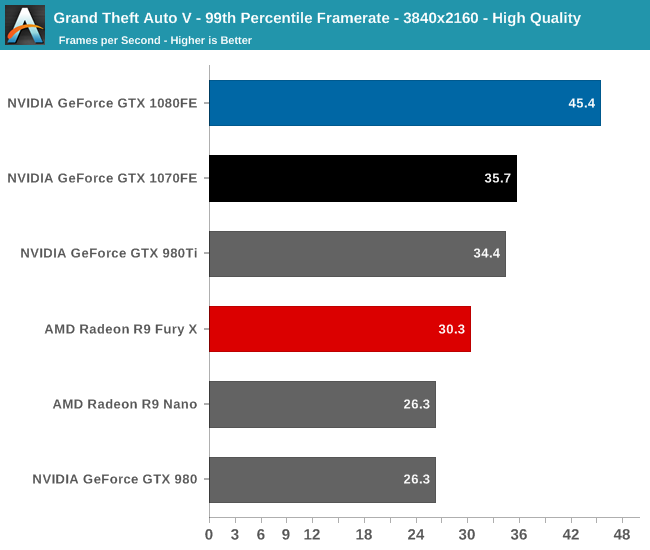
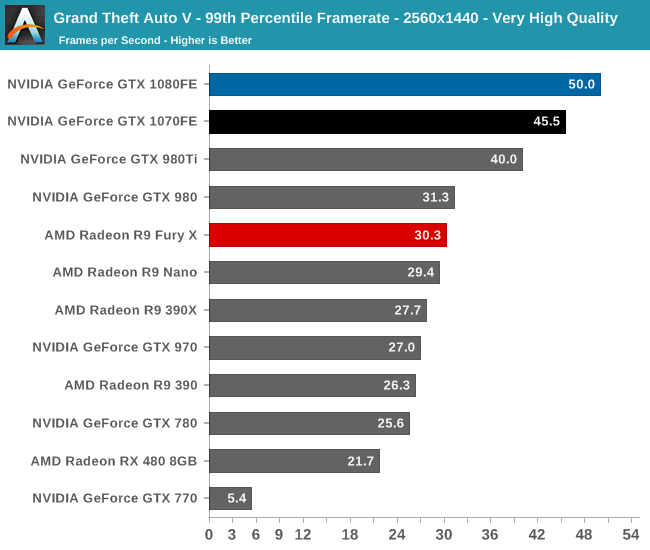
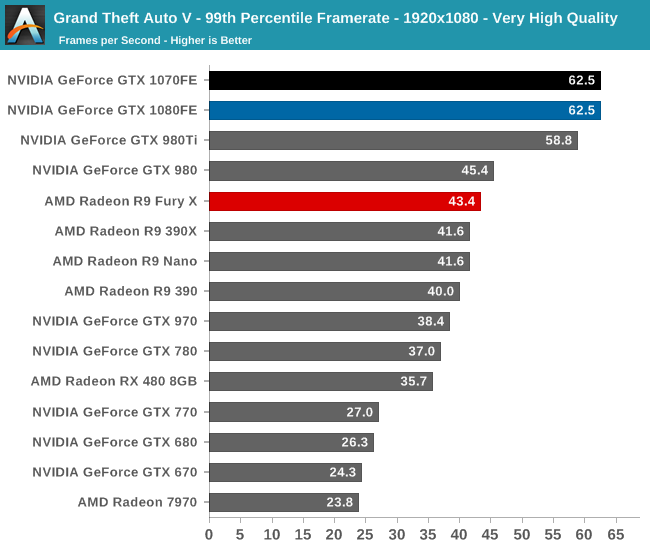










200 Comments
View All Comments
Ryan Smith - Wednesday, July 20, 2016 - link
Thanks.Eden-K121D - Wednesday, July 20, 2016 - link
Finally the GTX 1080 reviewguidryp - Wednesday, July 20, 2016 - link
This echoes what I have been saying about this generation. It is really all about clock speed increases. IPC is essentially the same.This is where AMD lost out. Possibly in part the issue was going with GloFo instead of TSMC like NVidia.
Maybe AMD will move Vega to TSMC...
nathanddrews - Wednesday, July 20, 2016 - link
Curious... how did AMD lose out? Have you seen Vega benchmarks?TheinsanegamerN - Wednesday, July 20, 2016 - link
its all about clock speed for Nvidia, but not for AMD. AMD focused more on ICP, according to them.tarqsharq - Wednesday, July 20, 2016 - link
It feels a lot like the P4 vs Athlon XP days almost.stereopticon - Wednesday, July 20, 2016 - link
My favorite era of being a nerd!!! Poppin' opterons into s939 and pumpin the OC the athlon FX levels for a fraction of the price all while stompin' on pentium. It was a good (although expensive) time to a be a nerd... Besides paying 100 dollars for 1gb of DDR500. 6800gs budget friendly cards, and ATi x1800/1900 super beasts.. how i miss the dayseddman - Thursday, July 21, 2016 - link
Not really. Pascal has pretty much the same IPC as Maxwell and its performance increases accordingly with the clockspeed.Pentium 4, on the other hand, had a terrible IPC compared to Athlon and even Pentium 3 and even jacking its clockspeed to the sky didn't help it.
guidryp - Wednesday, July 20, 2016 - link
No one really improved IPC of their units.AMD was instead forced increase the unit count and chip size for 480 is bigger than the 1060 chip, and is using a larger bus. Both increase the chip cost.
AMD loses because they are selling a more expensive chip for less money. That squeezes their unit profit on both ends.
retrospooty - Wednesday, July 20, 2016 - link
"This echoes what I have been saying about this generation. It is really all about clock speed increases. IPC is essentially the same."- This is a good thing. Stuck on 28nm for 4 years, moving to 16nm is exactly what Nvidias architecture needed.